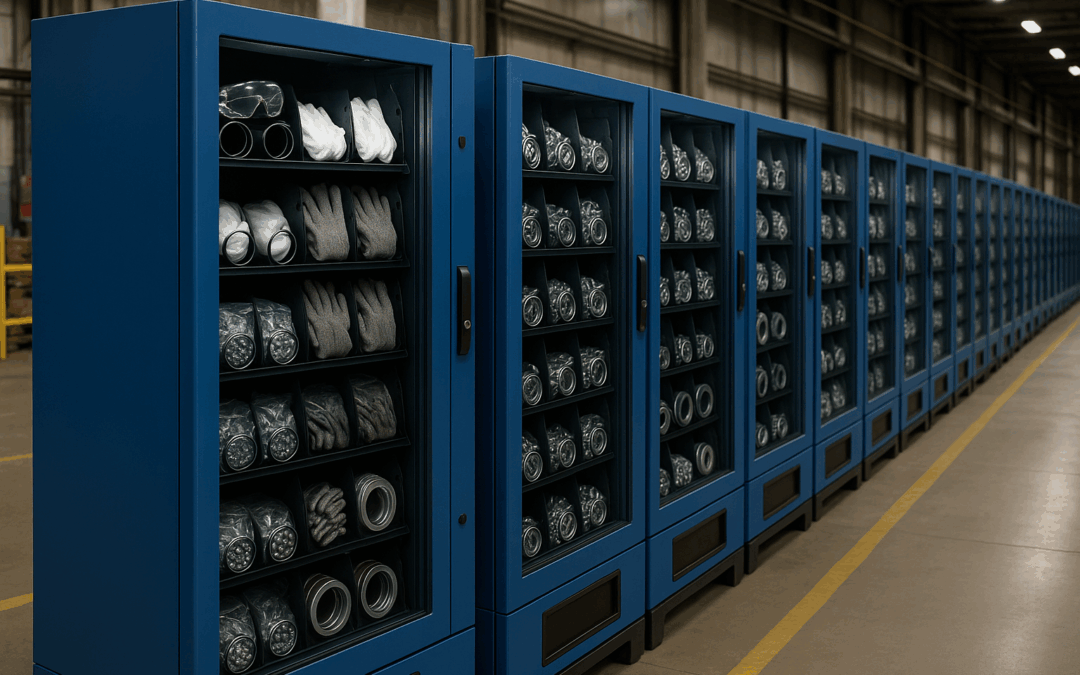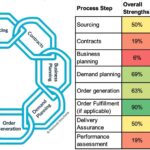There’s only one place I’ll use the word “vendor” instead of “supplier” regularly: Vendor-Managed Inventory (VMI). Why? First, because this is an industry-wide and well-accepted term for having a supplier (or vendor) take charge of your stocking levels, refill used materials, and sometimes even decide which items the vendor stocks. Second, because vendors who provide VMI tend to be . . . vendors. While they would like to be the strategic partner that suppliers represent, VMI programs are more like selling hot dogs than strategic solutions. (More on this distinction in this article.) So today’s article is about VMI: which suppliers provide VMI programs, pitfalls of the most commonly used program, and concrete tips on how to improve your own VMI program.
Common VMI Suppliers
Adding a little more color, VMI is when a vendor manages a company’s inventory. This typically means the vendor will have bins or a vending machine set up and will come by and stock those bins/vending machines regularly (daily, weekly, monthly, etc.) with their product. There are variations on this theme where the vendor may stock or manage items from another supplier, where the product is more or less accessible to employees, or where the company only calls the vendor as needed to restock when materials are low. Let’s talk about a few of the suppliers who offer programs in this space. I know this list is not comprehensive, but it’s the list I’ve either worked with myself or negotiated with for clients.
Fastenal – considered the premier VMI option, Fastenal is almost always a VMI front-runner. They offer vending machines, stocked by a Fastenal rep, that track which employee took which items out of the machines and when. Fastenal is definitely a front runner in this type of program and many manufacturers have implemented it, but they are certainly not alone in running VMI programs.
Nott Company – this is a smaller company who stocks more hydraulic components, but they were one of my first personal experiences with VMI and so they get a shout out. Their current approach involves using scanners and software to either restock bins or send items for the company to restock. This is a big improvement over their previous approach where the buyer had to manually call them to restock bins that were low.
Würth Industry – Würth is likely one of the most direct competitors to Fastenal, supplying hardware like nuts and bolts and catching up quickly in the vending machine game. When I worked with one of their now subsidiaries, Des Moines Bolt, the biggest value I found was that they were extremely fast to get me parts (usually hours, not days) and if I sent them a big list of hardware for a prototype build, they would kit up the hardware by subassembly and make sure I had all of it neatly organized by the time I built the prototype. I don’t know if all of their locations are like that, but shout out to the Würth Industrial team in Bondurant, IA.
MSC Supply – a big name in manufacturing for a long time (and one of the most direct competitors to McMaster Carr), MSC Supply is working on their VMI game. The advantage here is the very wide variety of parts they provide across a similarly wide variety of industries. I haven’t worked with their VMI program directly, so I can’t speak from experience, but I do consider them one of the large companies racing to catch up with Fastenal.
Grainger – another titan in the industrial and manufacturing space, Grainger has been adding VMI. I’m not sure how well they’re doing at keeping up in this space, as they are similar to MSC Supply in their VMI approach. I suspect from what I know working with them that a company has to be a fairly large customer before they will provide VMI, and they’re more likely to sell the racks and bins for other VMI programs than be the core to a company’s VMI program themselves.
Side note: I tried to use ChatGPT to help me find any major VMI suppliers I’ve missed, because I’m sure there are some out there. It was deeply unhelpful and didn’t even come up with Fastenal. So either I have the wrong prompt (possible) or this is just one of those things ChatGPT doesn’t yet handle well.
VMI Pitfalls
Vendor-managed inventory is awesome when done well. It saves time, might dramatically reduce the inventory on a company’s books, reduces risk, and helps ensure a company has the right items on hand. Like any supply chain tool, it has its pitfalls.
- Reporting – make sure you know what reporting you want from a supplier before signing a VMI contract. Do you just want a monthly statement of what was purchased? What about knowing what they are stocking back at their warehouse for you? Or even what their numbers say you are ordering for the next 3-6 months, almost like a reverse forecast? Be careful not to ask for a bunch of difficult data you won’t use, but do ask for reports that will matter and will help move your business forward.
- Vending Machine Rental – this is a fun one. Did you know as of early 2025, Fastenal’s vending machine rental cost was $40 per machine per month in the US? Even more interesting, this rental fee appears nowhere in their standard contract. The fee applies if that machine moves $0 in product or $1m in product each month. If you try to dispute it as a cost not in the contract, chances are good Fastenal will simply pull the machine. So inquire if there is a fee for the vending machine itself and get that fee negotiated and set down in the contract.
- Proximity Matters – depending on how your vendor manages your VMI, note that they usually have to be physically in your factory to restock their items. Otherwise, what you have is a Kanban or replenishment system, not VMI. Their headquarters doesn’t have to be close to you, but they do need a plan and a representative located near enough to actually manage your vendor-managed inventory. If you are paying for freight and you are not a tax-exempt company (most manufacturers are, but some other industries are not), make sure you keep that freight fee separate to avoid being taxed on freight if you are in a state where freight is non-taxable.
- Plan Cash Flow – know when you will be charged for VMI items. Is it when the vendor stocks the bins/vending machines? Or is it when those parts are issued out to the floor? In the first scenario, the company takes on the inventory risk and the inventory carrying costs. In the second scenario, the vendor carries that risk. Remember that risk always comes inverse of cost, so make sure if you are carrying the risk that you are also getting the lower cost in compensation.
VMI Best Practices
While there are many best practices for VMI, most of them are more company- or industry-specific. Here are a couple that apply across multiple industries:
- VMI your tail spend – VMI plays very well with that ABC XYZ inventory classification we’ve already talked about a few months ago. Take your BZ and CY “headache” parts and throw them into your VMI program. Chances are good these parts are also deep in your tail spend, so they’re doubly ripe for VMI.
- Make costs visible – one of the best things I’ve ever done with vending machines is simply post the prices of items next to parts. Most employees want to do the right thing and only take the items they truly need to do their job. If you make it very visible that one pair of safety glasses is $7 per pair and the other is $1.50 per pair, you accomplish two things: first, you let the employees understand the difference between the two glasses. Some employees will still take the $7 pair and that’s fine, but they will probably also take new glasses less frequently and take better care of them knowing they are the “good” ones. Second, it reminds employees that you can see what comes out of the vending machine and who takes it. Very nice personal protective equipment tends to disappear out of inventories right before Christmas, and this helps just a little more with that phenomenon. Note that you can even do this without a VMI program – helping employees understand the true prices of products tends to drive down costs.
- Assign the right resources – make sure your VMI program has enough internal resources for audit, management, any reordering needed, software troubleshooting, etc. As with all things, you cannot simply “set it and forget it.” Keep an eye on how spend is flowing through your VMI, how your supplier/vendor is approaching the program, and whether it is meeting the value and KPIs you seek.
A vendor-managed inventory program can dramatically decrease costs, risks, and stock outs when managed well. Avoid the pitfalls and be thoughtful about implementation if you have been tasked with implementing VMI. If you would like to talk about your company’s VMI program, let’s chat. If you’d like to get these articles weekly straight to your inbox and never miss one, sign up for my newsletter.
My book, Transform Procurement: The Value of E-auctions is now available in ebook, paperback and even hardcover format: https://www.amazon.com/dp/B0F79T6F25




